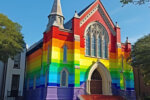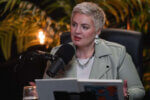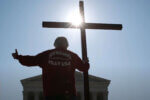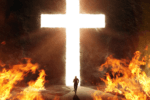Charismatic songs boomed over the public address system at the TWA Dome in St. Louis as colorfully outfitted women and children danced in the aisles. Hundreds of others, in single file, streamed through the aisles carrying banners proclaiming their faith.
In the crowd nuns dressed in habits worshiped side-by-side with teen-agers clad in T-shirts, baggy pants and sandals. Praise, worship and prayer language filled the Dome. Some became so excited they formed human chains by linking hands with others before setting off in a combination skip-dance around the Dome. Occasionally, someone would blow a shofar and the worship would rise to another level.
The enthusiastic praise and worship was part of Celebrate Jesus 2000, a Spirit-filled ecumenical congress sponsored by the North American Renewal Service Committee (NARSC). The purpose of the four-day congress in June was to serve as a gathering place for charismatic Protestants, Roman Catholics, Pentecostals and nondenominational members to experience reconciliation, revival and the power of the Holy Spirit.
According to David Apperley, director of the congress, more than 5,000 of the 8,500 pre-registrants were Catholics. Congress organizers had hoped for an even split between Catholics and non-Catholics.
“One big ecumenical gathering is not big news like it used to be,” said Vinson Synan, chairman of the NARSC executive committee,
explaining why he believes non-Catholics shied away from the event. “But still there is a place for this kind of meeting.”
NARSC, according to its statement of policy, is a coalition of Christian churches, denominations and ministries working toward unity in an effort to benefit world evangelization. More than 50,000 people attended the first NARSC-sponsored congress in Kansas City, Mo., in 1977.
Since then, however, the number of people attending has steadily declined,
and the lack of non-Catholics at this year’s congress has raised questions about whether or not the movement is losing steam.
Synan believes non-Catholic participation was down this year because St. Louis is almost 27 percent Catholic, thus more Catholics attended. The committee had considered holding the congress this year in Atlanta, where only 2 percent of the population are Catholic.
Doing so, Synan said, would have meant that more Pentecostals, Protestants and mainliners would have attended. At the NARSC congress in Orlando in 1995 more Protestants than Catholics attended, he pointed out.
“We had only one-third Catholic in Orlando and two-thirds here,” he said. “It depends on where you meet. The geography had something to do with it.”
But other congress leaders said the disparity between the number of Catholics and non-Catholics had to do with more than just geography.
“There are a lot of misconceptions about what Catholics believe,” said Nancy Kellar, a nun and a member of the NARSC executive committee. “I would challenge pastors in the Protestant and nondenominational world to find out the truth [about Catholic beliefs] and let their people know about some of those things.”
Both Catholic and non-Catholic attendees said the congress was successful in its bid to build unity, spark revival and encourage reconciliation.
“What I really like about [the conference] is how the many denominations come together and are here to worship Christ,” says Jeanne Fedler, a Catholic from Iowa. “There are no walls, and that is so neat.”
Jeremiah Grimes, a member of the local steering committee for the conference and pastor of a Church of God in Christ church in St. Louis, agrees.
“Although there have not been a lot of Protestants who have responded to the congress, we have emphasized the things we agree on,” he said. “Racial reconciliation and harmony is being achieved here. There is unity among the denominations and the races.”
During one afternoon session two long lines extended down the middle aisle of a large room. In the makeshift altar area worshiper after worshiper fell into the waiting arms of volunteers after being slain in the Spirit.
In another room hundreds learned how to pray, prepare and preach for revival. That night during the evening session a speaker asked if there should be another conference. Across the auditorium people pumped their fists, chanting, “Yes, yes, yes!”
Despite the paltry turnout of non-Catholics, Synan and other conference organizers said they were encouraged by the event. Synan admits things have changed in the movement since the late 1970s and early 1980s when it was so strong, but he believes that even though there are fewer demonstrations of unity between Protestants and Catholics, a deep desire for it still exists.
“There are just not as many opportunities to demonstrate that unity. This is one of the few in the world,” he said. “Even though there are less manifestations of unity it is still deep within people’s hearts.”
Beyond the success or failure of this year’s conference, the future of NARSC and the conferences it sponsors are at least uncertain. Synan is optimistic.
“We will have to decide what our future course is going to be after this because we haven’t really had a long-term vision beyond 2000 except we are joining with the Pentecostals in the Pentecostal World Conference,” he said. “Beyond that we haven’t made any decisions. But this congress has been so successful, it makes us feel like maybe we should keep it up.”






Leave a Comment
You must be logged in to post a comment.